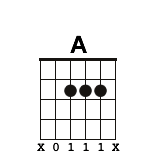7 Basic Guitar Chords for Beginners...
If you are looking for easiest possible guitar chords for beginners, then these are the ones to start with...
This lesson covers the most basic guitar chords for beginner players. These beginning guitar chords are the first ones every guitar player should learn.
They are sometimes referred to as open position chords, because they are played in the first few frets of the guitar and all contain at least one open string.
E Minor Chord:
The Em ranks as one of the first beginning guitar chords that you should learn. It uses all six of the guitar strings. It’s one of the most basic guitar chords not only because it’s easy, but because it’s used all the time in a lot of different songs. The small "m" after the "E" designates the minor chord quality. Think of minor as a darker color of sound.
C Major Chord:
Another important basic beginner guitar chord you should learn is the C, or "C major." You technically don’t have to say “major” in the name of the chord. If you just say "C chord" it’s recognized by other musicians that it’s understood to be a major chord. You only want to strum the strings 5 through to 1 (that means the highest "sounding" 5 strings, not their relationship to the floor) The X in the guitar chord chart means "do not to play" that string. This can be done either through the strumming hands coverage of the strings, or through muting technique.
G Major Chord:
The G chord is another important beginner's chord to know. For the G major guitar chord there are two fingerings listed. The one in black is the fingering generally recommended. The one in black may seem more awkward at first (only because you are using your 4th finger, which is your weakest finger). That fingering makes the smoothest transition with C, which happens all the time in different songs.
D Major Chord:
With the addition of a D major guitar chord, you can play the chords to literally thousands of songs. Write yourself some catchy lyrics and you could use the chords discussed so far to compose a short song. The biggest problem encountered with this basic guitar chord is getting the first string to sound clearly. Make sure your third finger is not touching the first string. Get the string on the tip of your 3rd finger to solve this issue.
A Minor Chord:
An "A minor" guitar chord has two fingers in common with the C chord. And, quite often in songs we will find a switch occurring between these two. To switch from C to Am just lift up your third finger and move it to the 3rd string, 2nd fret. You will only have to move your 2nd finger back slightly within the fret to make room for your 3rd finger.
E Major Chord:
An E major guitar chord is the same shape as the Am chord, (only moved to the 5th, 4th and 3rd strings). The E chord is also like the Em chord, only the "E Major" is adding your first finger on the first fret of the 3rd string. Many guitar chords will have similar, or the exact same shapes, when moved between string sets, (especially between a 6th-string root to the 5th-string root). Watch for this as you learn more chords. It will be a great help to their memorization.
A Major Chord:
When learning the "A" chord, there are a few different fingerings. They are going to be useful in different situations, so over time explore different techniques. However, the most common approach will use a "Barre" technique to flatten the finger down across the strings of the second fret and cover the interior strings of 4th to 2nd. The upper string (1st), needs to be muted with the underside of your index (barred) finger.
___________________________________________________
GET GOOD NOW - JOIN THE MEMBERS AREA
Guitar Chords | F Chord | Guitar Notes | G Chord | C Chord | D Chord | Guitar String Notes












